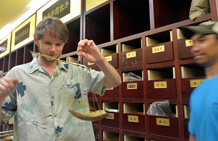
China sets up new system to optimize medical resources
Source: english.gov.cn
Updated: 2015-09-16
The General Office of the State Council issued a statement on Sept 11, asking its departments and local authorities to set up a system allowing hospitals to target specific patient groups so that medical resources can be utilized more efficiently.
The system, initially, should be in place in 2017 before becoming fully operational in 2020, it said. Authorities should channel quality medical resources to community medical institutions, improve the ability of general practitioners at these institutions, leading to an increase in the number of patients visiting these institutions.
By 2020, when most patients will first visit community medical institutions for medical service, top-level hospitals and community-based ones will be able to transfer patients to, and receive them from, each other more smoothly, and patients with acute diseases and chronic diseases will go to different hospitals.
Top-level hospitals, the statement said, should focus on research, nurturing talent and treating critical and complex health conditions, while community-based ones should focus on offering long-term care and rehabilitation for those with conditions that have been diagnosed and are stable, including people with chronic diseases and people diagnosed in the late stages of cancer.
More training programs should be offered to community doctors so that they can function as general practitioners. There should be two to three general practitioners for every 10,000 residents. The authorities should encourage large or top-level hospitals to form a medical group with community hospitals and the top-level hospitals should encourage their doctors to work in community hospitals on a regular basis, in order to improve the service community hospitals offer.
They should improve the service offered by county-level public hospitals, so that residents in one county don’t have to travel outside it for treatment of major diseases.
Medical resources owned by hospitals above the community level, such as test labs and central sterile supply departments, should be open to community hospitals.
The authorities should try establish institutions that specialize in testing, sterilizing and dialysis, and whose services can be shared by all medical institutions in the neighborhood.
People should be able to access their electronic health profiles and medical records, which can be shared among different medical institutions.
Top-level hospitals should not plan on expanding but instead share resources, while doctors at community hospitals should sign contracts of service with the residents and offer medical services to the elderly, patients with chronic diseases or serious mental health problems, pregnant women, children and those suffering disabilities. Community doctors should be able to prescribe medicines for chronic diseases.
The public health insurance program should be reformed to control medical costs and the price of medicines and tests should be lowered. Doctors should also be better compensated for diagnosis and treatment.

World Family Summit
The World Family Organization was founded in Europe in 1947 and headquartered in Paris.
Link: China's Central Government / World Health Organization / United Nations Population Fund / UNICEF in China
Copyright 2014 National Health and Family Planning Commission of the PRC All rights reserved






